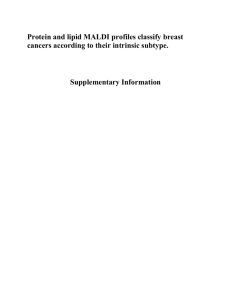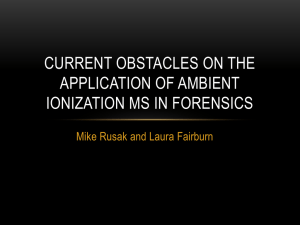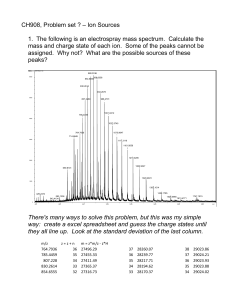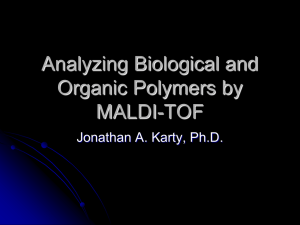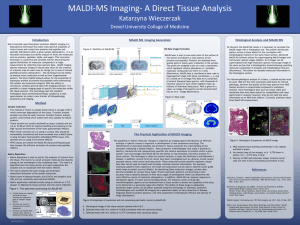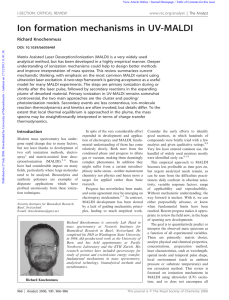Kevin G. Owens
advertisement
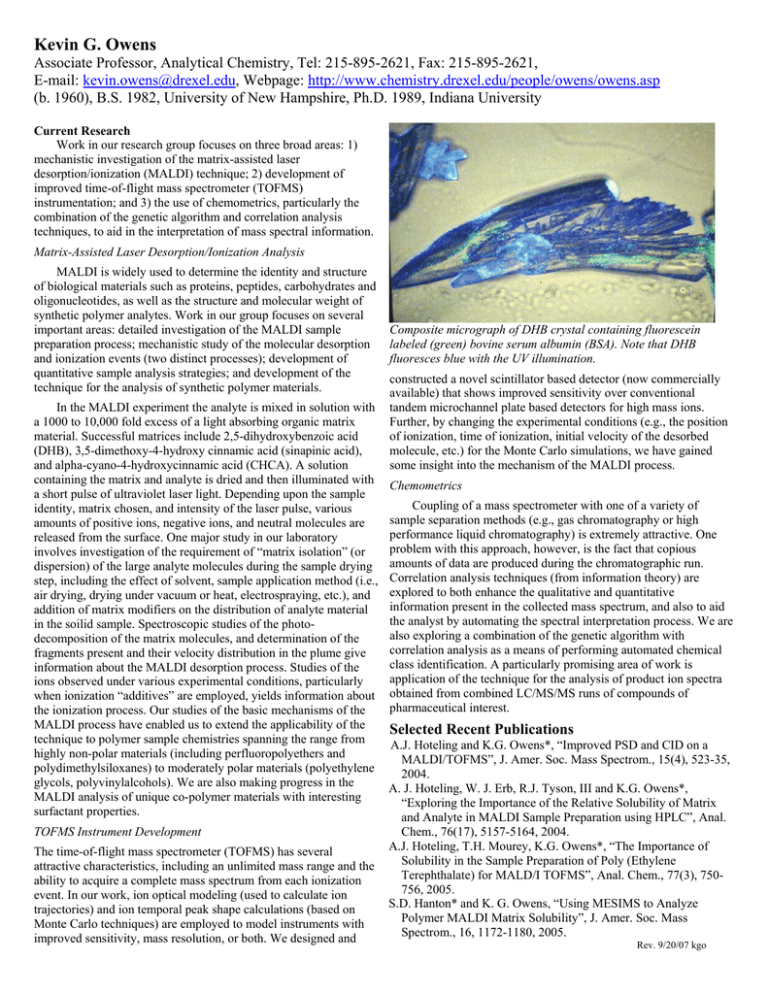
Kevin G. Owens Associate Professor, Analytical Chemistry, Tel: 215-895-2621, Fax: 215-895-2621, E-mail: kevin.owens@drexel.edu, Webpage: http://www.chemistry.drexel.edu/people/owens/owens.asp (b. 1960), B.S. 1982, University of New Hampshire, Ph.D. 1989, Indiana University Current Research Work in our research group focuses on three broad areas: 1) mechanistic investigation of the matrix-assisted laser desorption/ionization (MALDI) technique; 2) development of improved time-of-flight mass spectrometer (TOFMS) instrumentation; and 3) the use of chemometrics, particularly the combination of the genetic algorithm and correlation analysis techniques, to aid in the interpretation of mass spectral information. Matrix-Assisted Laser Desorption/Ionization Analysis MALDI is widely used to determine the identity and structure of biological materials such as proteins, peptides, carbohydrates and oligonucleotides, as well as the structure and molecular weight of synthetic polymer analytes. Work in our group focuses on several important areas: detailed investigation of the MALDI sample preparation process; mechanistic study of the molecular desorption and ionization events (two distinct processes); development of quantitative sample analysis strategies; and development of the technique for the analysis of synthetic polymer materials. In the MALDI experiment the analyte is mixed in solution with a 1000 to 10,000 fold excess of a light absorbing organic matrix material. Successful matrices include 2,5-dihydroxybenzoic acid (DHB), 3,5-dimethoxy-4-hydroxy cinnamic acid (sinapinic acid), and alpha-cyano-4-hydroxycinnamic acid (CHCA). A solution containing the matrix and analyte is dried and then illuminated with a short pulse of ultraviolet laser light. Depending upon the sample identity, matrix chosen, and intensity of the laser pulse, various amounts of positive ions, negative ions, and neutral molecules are released from the surface. One major study in our laboratory involves investigation of the requirement of “matrix isolation” (or dispersion) of the large analyte molecules during the sample drying step, including the effect of solvent, sample application method (i.e., air drying, drying under vacuum or heat, electrospraying, etc.), and addition of matrix modifiers on the distribution of analyte material in the soilid sample. Spectroscopic studies of the photodecomposition of the matrix molecules, and determination of the fragments present and their velocity distribution in the plume give information about the MALDI desorption process. Studies of the ions observed under various experimental conditions, particularly when ionization “additives” are employed, yields information about the ionization process. Our studies of the basic mechanisms of the MALDI process have enabled us to extend the applicability of the technique to polymer sample chemistries spanning the range from highly non-polar materials (including perfluoropolyethers and polydimethylsiloxanes) to moderately polar materials (polyethylene glycols, polyvinylalcohols). We are also making progress in the MALDI analysis of unique co-polymer materials with interesting surfactant properties. TOFMS Instrument Development The time-of-flight mass spectrometer (TOFMS) has several attractive characteristics, including an unlimited mass range and the ability to acquire a complete mass spectrum from each ionization event. In our work, ion optical modeling (used to calculate ion trajectories) and ion temporal peak shape calculations (based on Monte Carlo techniques) are employed to model instruments with improved sensitivity, mass resolution, or both. We designed and Composite micrograph of DHB crystal containing fluorescein labeled (green) bovine serum albumin (BSA). Note that DHB fluoresces blue with the UV illumination. constructed a novel scintillator based detector (now commercially available) that shows improved sensitivity over conventional tandem microchannel plate based detectors for high mass ions. Further, by changing the experimental conditions (e.g., the position of ionization, time of ionization, initial velocity of the desorbed molecule, etc.) for the Monte Carlo simulations, we have gained some insight into the mechanism of the MALDI process. Chemometrics Coupling of a mass spectrometer with one of a variety of sample separation methods (e.g., gas chromatography or high performance liquid chromatography) is extremely attractive. One problem with this approach, however, is the fact that copious amounts of data are produced during the chromatographic run. Correlation analysis techniques (from information theory) are explored to both enhance the qualitative and quantitative information present in the collected mass spectrum, and also to aid the analyst by automating the spectral interpretation process. We are also exploring a combination of the genetic algorithm with correlation analysis as a means of performing automated chemical class identification. A particularly promising area of work is application of the technique for the analysis of product ion spectra obtained from combined LC/MS/MS runs of compounds of pharmaceutical interest. Selected Recent Publications A.J. Hoteling and K.G. Owens*, “Improved PSD and CID on a MALDI/TOFMS”, J. Amer. Soc. Mass Spectrom., 15(4), 523-35, 2004. A. J. Hoteling, W. J. Erb, R.J. Tyson, III and K.G. Owens*, “Exploring the Importance of the Relative Solubility of Matrix and Analyte in MALDI Sample Preparation using HPLC”, Anal. Chem., 76(17), 5157-5164, 2004. A.J. Hoteling, T.H. Mourey, K.G. Owens*, “The Importance of Solubility in the Sample Preparation of Poly (Ethylene Terephthalate) for MALD/I TOFMS”, Anal. Chem., 77(3), 750756, 2005. S.D. Hanton* and K. G. Owens, “Using MESIMS to Analyze Polymer MALDI Matrix Solubility”, J. Amer. Soc. Mass Spectrom., 16, 1172-1180, 2005. Rev. 9/20/07 kgo
